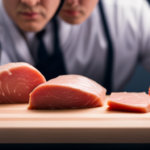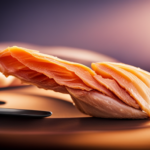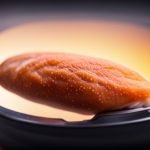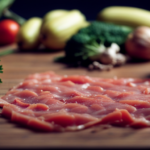Getting Started with Raw Food
If Cooked Food Touches A Spot Where Raw Chicken Was, Is It Okay?

Imagine this scenario: you are in the kitchen, getting ready to cook a tasty meal for your family. When you grab a plate, you see a tiny area where uncooked chicken was placed before. You begin to worry if it is safe to use that plate for your cooked food. Is it safe?
The answer lies in the realm of cross-contamination, a concept that can make or break your culinary endeavors. Cross-contamination occurs when bacteria from one food item transfers to another, potentially leading to foodborne illnesses. In the case of raw chicken, the risk is even higher. Salmonella, Campylobacter, and other harmful bacteria can lurk on its surface, waiting to wreak havoc on your health.
But fear not, my meticulous reader. By understanding safe handling practices, cooking temperatures, and expert recommendations, you can navigate the treacherous waters of cross-contamination and make informed decisions about food safety. Join us as we delve into the world of food hygiene, empowering you to protect yourself and your loved ones from potential hazards.
Key Takeaways
- Cross-contamination can occur when cooked food comes into contact with surfaces or utensils that have been contaminated with raw chicken.
- Proper hygiene practices, such as washing hands thoroughly and using separate cutting boards and utensils for raw and cooked chicken, can help prevent cross-contamination.
- It is important to store raw chicken properly in leak-proof containers on the lower shelves of the refrigerator to avoid contact with other foods.
- Cooking chicken thoroughly to an internal temperature of at least 165°F (74°C) is essential for killing bacteria and preventing foodborne illnesses.
Understanding Cross-Contamination Risk
If cooked food comes into contact with a surface that previously touched raw chicken, it’s crucial to understand the potential risks of cross-contamination. Preventing cross-contamination in food preparation is of utmost importance to ensure the safety of your meals.
Cross-contamination occurs when harmful bacteria from raw food, like chicken, are transferred to ready-to-eat or cooked food. This can happen through direct contact or indirectly, via utensils, cutting boards, or countertops.
Bacteria play a significant role in cross-contamination. They can be present on raw chicken and can cause foodborne illnesses if not handled properly. Salmonella and Campylobacter are two common bacteria found in raw poultry that can lead to severe stomach cramps, diarrhea, and vomiting. These bacteria can survive on surfaces and multiply rapidly, even at room temperature.
To prevent cross-contamination, it’s essential to follow meticulous food safety practices. Start by using separate cutting boards and utensils for raw chicken and other foods. Wash your hands thoroughly after handling raw chicken or any other raw meat. Ensure that surfaces, utensils, and equipment are properly cleaned and sanitized after each use. Additionally, store raw chicken in leak-proof containers on lower shelves of the refrigerator to prevent any drips onto other foods.
By understanding the risks of cross-contamination and implementing preventive measures, you can protect yourself and your loved ones from foodborne illnesses. Stay knowledgeable, meticulous, and authoritative in your food preparation practices to ensure safe and delicious meals.
The Importance of Proper Food Handling
Properly handling food is crucial to maintaining hygiene and preventing contamination. It is essential to adhere to strict guidelines when it comes to food handling, especially when dealing with raw chicken. Cross-contamination can occur when cooked food comes into contact with surfaces or utensils that have been contaminated by raw chicken. This can lead to the spread of harmful bacteria, such as Salmonella or Campylobacter, which can cause foodborne illnesses.
To prevent cross-contamination, it is important to follow proper hygiene practices. Always wash your hands thoroughly with soap and water before and after handling raw chicken. Use separate cutting boards and utensils for raw chicken and other foods to avoid the transfer of bacteria. It is also crucial to clean and sanitize all surfaces and utensils that have come into contact with raw chicken.
To emphasize the significance of proper food handling, let’s take a look at the following table:
| Proper Food Handling Practices | Importance |
|---|---|
| Wash hands before and after handling raw chicken | Removes bacteria from hands |
| Use separate cutting boards and utensils for raw chicken | Prevents cross-contamination |
| Clean and sanitize surfaces and utensils after use | Kills bacteria and prevents spread |
By following these meticulous practices, you can ensure that your cooked food remains safe and free from contamination. Remember, proper food handling is not only necessary for your own health but also for the well-being of those who consume your meals.
Potential Foodborne Illnesses from Raw Chicken
When handling raw chicken, it’s crucial to be aware of the potential foodborne illnesses that can lurk beneath its surface. Preventing cross contamination is key in ensuring the safety of your cooked food.
Raw chicken can be contaminated with bacteria such as Salmonella and Campylobacter, which can cause serious illnesses if ingested. Salmonella is one of the most common foodborne illnesses associated with raw chicken. It can cause symptoms like diarrhea, fever, and abdominal cramps. Campylobacter is another common bacteria found in raw chicken, and it can lead to symptoms such as diarrhea, nausea, and vomiting.
To prevent cross contamination, it is important to follow proper food handling procedures. Keep raw chicken separate from other foods, especially those that will be eaten raw or without further cooking. Use separate cutting boards and utensils for raw chicken to avoid spreading bacteria to other foods.
Additionally, make sure to cook chicken thoroughly to kill any bacteria that may be present. Use a food thermometer to ensure that the internal temperature reaches at least 165°F (74°C). This will help to eliminate any potential pathogens and reduce the risk of foodborne illnesses.
By being diligent in preventing cross contamination and properly cooking raw chicken, you can significantly reduce the risk of common foodborne illnesses associated with this poultry. Stay informed and take the necessary precautions to keep yourself and your loved ones safe.
Evaluating the Level of Contamination
Take a moment to assess the level of contamination in your kitchen, and remember that your loved ones’ health is at stake. When it comes to evaluating the risk of contamination from raw chicken, there are a few key factors to consider.
-
The first thing to assess is the extent of contact between the cooked food and the spot where the raw chicken was. If the cooked food only briefly came into contact with the raw chicken, the risk of contamination may be minimal. However, if the raw chicken juices or particles were left on the surface and the cooked food was in prolonged contact with them, the risk of contamination increases significantly.
-
Another important factor is the temperature at which the cooked food and the raw chicken were stored. If the cooked food was stored at a safe temperature and the raw chicken was properly refrigerated, the risk of contamination is lower. However, if the food was left at room temperature for an extended period, bacteria can multiply rapidly, increasing the risk of foodborne illness.
-
Lastly, consider the overall cleanliness of your kitchen. If your kitchen is well-maintained, regularly cleaned, and proper food handling practices are followed, the risk of contamination is minimized. However, if your kitchen is not kept clean or if cross-contamination is common, the risk of spreading harmful bacteria from raw chicken to cooked food is higher.
In order to minimize the risk of contamination, it’s crucial to handle raw chicken with care, ensuring proper storage, and maintaining cleanliness in your kitchen. By following these practices, you can help protect the health of your loved ones and reduce the risk of foodborne illnesses.
Safe Handling Practices in the Kitchen
To keep your kitchen safe, it’s important to practice proper handling techniques. Understanding hygiene practices and preventing cross-contamination are essential in maintaining a healthy environment for food preparation.
When it comes to handling raw chicken, it’s crucial to take extra precautions. First and foremost, always wash your hands thoroughly with soap and warm water before and after handling raw chicken. This will help eliminate any bacteria that may be present on your hands.
Additionally, make sure to clean and sanitize all utensils, cutting boards, and surfaces that come into contact with raw chicken. Using separate cutting boards for raw meats and other ingredients can help prevent cross-contamination.
It’s also important to store raw chicken properly in the refrigerator. Keep it in a leak-proof container on the bottom shelf to avoid any drips or spills onto other foods. Be mindful of not overcrowding the refrigerator, as this can lead to inadequate cooling and potential bacterial growth.
When cooking chicken, ensure it reaches a safe internal temperature of 165°F (74°C) to kill any harmful bacteria. Using a food thermometer is the best way to accurately determine if the chicken is cooked thoroughly.
By following these safe handling practices, you can significantly reduce the risk of contamination and keep your kitchen a safe and healthy space for food preparation. Stay vigilant and prioritize hygiene to maintain a clean and safe environment.
Cleaning and Sanitizing Surfaces
When it comes to safe handling practices in the kitchen, it’s crucial to pay close attention to cleaning and sanitizing surfaces. This is especially important in preventing cross-contamination, where harmful bacteria can spread from one surface to another.
To ensure the safety of your cooked food, it’s essential to thoroughly clean and disinfect any surfaces that have come into contact with raw chicken or its juices. This includes cutting boards, countertops, knives, and any other utensils used during the preparation process.
Surface disinfection is an effective way to kill bacteria and other pathogens that may be present. You can use a solution of bleach and water, or a commercial disinfectant specifically designed for kitchen use. Remember to follow the manufacturer’s instructions for proper dilution and contact time.
Meticulous cleaning and sanitizing of surfaces will greatly reduce the risk of cross-contamination and help keep your kitchen safe and hygienic. By taking these extra precautions, you can enjoy your meals knowing that you’ve done everything possible to protect yourself and your loved ones from foodborne illnesses.
So, remember, always clean and disinfect surfaces thoroughly to maintain a healthy and safe cooking environment.
Cooking Temperatures for Chicken
Make sure you know the proper cooking temperatures for chicken, so you can confidently serve a delicious and safe meal. Cooking chicken to the right temperature is crucial to kill any harmful bacteria that may be present.
Here are some important cooking techniques and food safety guidelines to keep in mind:
-
Internal Temperature: The internal temperature of cooked chicken should reach a minimum of 165°F (74°C). This ensures that any bacteria, such as salmonella or campylobacter, are effectively killed. Use a reliable food thermometer to accurately measure the temperature.
-
Cooking Methods: There are various cooking methods you can choose from, including baking, grilling, frying, or boiling. Regardless of the method you choose, it’s essential to reach the recommended internal temperature.
-
Preparing Different Cuts: Different cuts of chicken may require slightly different cooking times and temperatures. For example, bone-in chicken may take longer to cook compared to boneless chicken breasts. Always follow specific cooking recommendations for each cut.
-
Resting Time: After cooking, allow the chicken to rest for a few minutes. This helps the juices redistribute and ensures a juicier and more flavorful result.
By following these cooking techniques and food safety guidelines, you can enjoy a perfectly cooked chicken dish while keeping your family and guests safe from any potential foodborne illnesses. Remember, proper cooking temperatures are the key to a delicious and worry-free meal.
Assessing the Risk: Factors to Consider
Take into account various factors when assessing the risk associated with cooking chicken, ensuring you serve a safe and delicious meal.
One important factor to consider is the potential for cross-contamination. Cross-contamination occurs when cooked food comes into contact with surfaces or utensils that have been contaminated with raw chicken. This can happen if you place cooked food on a cutting board or plate that previously held raw chicken, or if you use the same utensils for both raw and cooked chicken without proper washing in between.
To evaluate the risk of cross-contamination, it’s crucial to practice good hygiene and sanitation. Always wash your hands thoroughly with soap and water before and after handling raw chicken. Use separate cutting boards and utensils for raw and cooked chicken to prevent any potential transfer of bacteria. Additionally, ensure that all surfaces and utensils are properly cleaned and sanitized after coming into contact with raw chicken.
Another factor to consider is the cooking temperature. Chicken should be cooked to an internal temperature of 165°F (74°C) to ensure that any harmful bacteria present are killed. Use a meat thermometer to accurately measure the temperature, as visual cues alone may not be sufficient.
By carefully assessing these risk factors, you can minimize the chances of cross-contamination and ensure that your cooked chicken is safe to eat. Remember to always prioritize food safety to protect yourself and your loved ones from foodborne illnesses.
Expert Recommendations on Handling Cross-Contamination
Now that you understand the various factors that contribute to the risk of cross-contamination, it’s important to know the expert recommendations on preventing it.
By following these best practices for food safety, you can significantly reduce the chances of contamination and keep yourself and your loved ones safe.
One of the most crucial steps in preventing cross-contamination is to thoroughly clean and sanitize all surfaces and utensils that come into contact with raw chicken. This includes cutting boards, knives, countertops, and any other items that may have been exposed to the raw chicken.
Experts also recommend using separate cutting boards and utensils for raw and cooked foods to minimize the risk of cross-contamination. This means having designated tools specifically for raw chicken and others for cooked food. Additionally, it’s important to wash your hands thoroughly with soap and water before and after handling raw chicken to avoid spreading bacteria.
Furthermore, storing raw chicken properly in the refrigerator is essential. It should be placed in a leak-proof container or sealed plastic bag to prevent any juices from coming into contact with other foods.
By following these expert recommendations and implementing best practices for food safety, you can greatly reduce the risk of cross-contamination in your kitchen. Stay vigilant, be meticulous in your approach, and prioritize the health and safety of yourself and those around you.
Conclusion: Making Informed Decisions about Food Safety
Remember, your knowledge about food safety is like a shield that protects you and your loved ones from the invisible dangers lurking in your kitchen. By making informed decisions about food safety, you can greatly reduce the risk of cross-contamination and keep your food safe to eat.
Here are some key points to consider when it comes to making informed decisions about food safety:
-
Separate: Always keep raw meats, poultry, seafood, and eggs separate from ready-to-eat foods. This prevents the spread of harmful bacteria from raw to cooked foods.
-
Clean: Properly clean and sanitize all surfaces, utensils, and cutting boards after they come into contact with raw foods. This helps eliminate any lingering bacteria that could contaminate other food items.
-
Cook: Ensure that all foods, especially meats and poultry, are cooked to the appropriate internal temperature. This kills off any harmful bacteria that may be present.
-
Store: Properly store leftovers in airtight containers and refrigerate them promptly. This prevents the growth of bacteria that can cause foodborne illnesses.
By following these guidelines and being mindful of the potential risks, you can confidently make informed decisions about food safety. Remember, it’s better to be cautious and take the necessary precautions than to risk the health and well-being of yourself and your loved ones.
Frequently Asked Questions
How long does it take for cross-contamination to occur?
Cross-contamination occurs when bacteria from raw chicken comes into contact with cooked food. The time it takes for cross-contamination to occur depends on several factors. These include the temperature, the type of bacteria present, and the length of time the food is left out.
Proper handling techniques, such as using separate cutting boards, utensils, and washing hands thoroughly, can help prevent cross-contamination. Following these practices is crucial to ensure food safety and prevent the spread of harmful bacteria.
Can cross-contamination occur if the raw chicken is packaged and separated from other foods?
Proper packaging and handling practices play a crucial role in preventing cross-contamination of raw chicken. Packaging precautions, such as using leak-proof containers and keeping raw chicken separate from other foods, can significantly reduce the risk of cross-contamination. When handling raw chicken, it’s essential to wash hands thoroughly before and after, use separate cutting boards and utensils, and avoid placing cooked food on surfaces that have come into contact with raw chicken.
Following these best practices can help ensure food safety and prevent cross-contamination.
Are there any specific areas in the kitchen that are more prone to cross-contamination?
Proper kitchen hygiene practices play a crucial role in preventing cross-contamination. It’s important to be meticulous when handling raw chicken and to use separate cutting boards for raw and cooked foods. By doing so, you minimize the risk of harmful bacteria spreading from the raw chicken to other areas of the kitchen.
Some areas that are more prone to cross-contamination include countertops, utensils, and sink surfaces. Adhering to these practices ensures food safety and protects against potential health risks.
Can cross-contamination occur if the raw chicken is cooked to a high temperature?
Do you really want to take a chance with cross-contamination? Proper food handling techniques are crucial to prevent the risks associated with consuming undercooked chicken. Even if raw chicken’s cooked to a high temperature, cross-contamination can still occur if cooked food touches a spot where raw chicken was.
It’s essential to maintain meticulous hygiene in the kitchen to ensure the safety of your meals. Don’t underestimate the importance of practicing proper food handling protocols.
Is it safe to eat cooked food that has come into contact with raw chicken if it has been refrigerated?
To ensure food safety, it’s crucial to follow proper handling techniques when dealing with raw chicken. This includes using separate cutting boards and utensils for raw chicken and other foods. By doing so, you can prevent cross-contamination and reduce the risk of foodborne illnesses.
If cooked food has come into contact with raw chicken, it’s generally safe to eat if it’s been refrigerated promptly. However, it’s still advisable to exercise caution and thoroughly reheat the food before consuming.
Is It Safe to Eat Food That Has Touched a Spot Where Raw Chicken Was?
It is not safe to eat food that has come into contact with raw chicken, as it can lead to raw meat cross-contamination with food. Bacteria from the raw chicken can easily transfer to other foods, causing foodborne illness. It’s crucial to practice proper food handling and keep raw meats separate from ready-to-eat items.
Conclusion
So, now you know the answer to the pressing question of whether it’s okay if cooked food touches a spot where raw chicken was. And the answer is… drumroll please… NO!
Cross-contamination is no joke when it comes to food safety. It’s like playing a dangerous game of culinary Russian roulette. But fear not, dear reader, for armed with knowledge about proper food handling and safe cooking temperatures, you can protect yourself from the perils of foodborne illnesses.
So next time, be meticulous in your kitchen practices and make informed decisions to keep your meals both delicious and safe.
Stay savvy, my friends.
With her ability to convey complex concepts in a clear and accessible manner, Belinda ensures that readers of all backgrounds can grasp the benefits and techniques of raw food. She excels at breaking down scientific information into digestible pieces, allowing readers to understand the impact of raw food on their bodies and encouraging them to make informed choices about their diet.
One of Belinda’s notable contributions to rachaelsrawfood.com is her collection of mouthwatering recipes. She delights in experimenting with various combinations of raw ingredients, exploring innovative ways to create delicious and nutritious meals. Belinda’s recipes showcase the incredible flavors and textures of raw food and emphasize its versatility, dispelling any misconception that a raw food diet is limited or monotonous.
In addition to her writing responsibilities, Belinda actively engages with the raw food community, attending workshops, seminars, and conferences to expand her knowledge and network. She enjoys connecting with like-minded individuals, exchanging ideas, and staying up to date with the latest trends and advancements in the field of raw food nutrition.
Benefits of Raw Food
Ryze Organic: Revolutionizing Your Morning Brew with Mushrooms

Coffee lovers, get ready to embark on a journey into the world of Ryze Organic Mushroom Coffee! This innovative brew is changing the game by combining the rich flavors of coffee with the powerful benefits of medicinal mushrooms. Let’s explore how Ryze is revolutionizing your morning ritual.
What is Ryze Organic Mushroom Coffee?
Ryze Organic Mushroom Coffee is a unique blend of organic coffee and six medicinal mushrooms sourced from US family farms. This special concoction aims to provide enhanced energy, improved focus, and various health benefits without the jitters often associated with traditional coffee.


The Medicinal Mushrooms in Ryze Coffee
Ryze Coffee incorporates six powerful medicinal mushrooms, each offering unique health benefits:
Key Points: Medicinal Mushrooms in Ryze Coffee
- Cordyceps: Boosts energy levels (Study: Colson et al., 2005)
- Lion’s Mane: Enhances cognitive function (Study: Mori et al., 2009)
- Shiitake: Supports immune system (Study: Dai et al., 2015)
- King Trumpet: Promotes gut health (Study: Huang et al., 2021)
- Turkey Tail: Aids in stress reduction (Study: Lindequist et al., 2005)
- Reishi: Improves sleep quality (Study: Soh et al., 2013)
This carefully curated blend of mushrooms works synergistically with coffee to provide a holistic wellness experience. For more information on the health benefits of these mushrooms, check out Coffee Lovers 101 Health and Wellness section.
Health Benefits of Ryze Organic Mushroom Coffee
Ryze Coffee offers a range of health benefits that set it apart from traditional coffee:
Health Benefits of Medicinal Mushrooms
With only 48mg of caffeine per cup, Ryze provides sustained energy without the crash often associated with higher caffeine content. Its low acidity also makes it gentle on the stomach, perfect for those with sensitive digestive systems.

How to Prepare and Enjoy Ryze Coffee
Preparing Ryze Coffee is simple and versatile. Here are some tips to get the most out of your brew:
- Mix a spoonful into hot water and stir well.
- Use a frother for a creamy, foamy texture.
- Add to your regular brewed coffee for an extra boost.
- Incorporate into lattes, smoothies, or even baked goods.
For more brewing tips and techniques, visit Coffee Lovers 101 Brewing Guides section.
Ryze Coffee vs. Traditional Coffee
Let’s compare Ryze Coffee to traditional coffee:
| Feature | Ryze Coffee | Traditional Coffee | Source |
|---|---|---|---|
| Caffeine Content | 48mg per cup | 95-200mg per cup | [1] |
| Acidity | Low | High | [2] |
| Energy | Sustained | Potential crash | [3] |
| Additional Health Benefits | Numerous | Limited | [4] |
| Mushroom Type | Lion’s Mane, Chaga, and Cordyceps | None | [5] |
| Organic Certification | USDA Organic | Varies by brand | [6] |
| Sustainability | Eco-friendly packaging, fair trade practices | Varies by brand | [7] |
Ryze Coffee offers a more balanced and health-conscious alternative to traditional coffee. Learn more about coffee culture and trends in Coffee Lovers 101 Coffee Culture section.

Frequently Asked Questions about Ryze Coffee
Here are some common questions about Ryze Organic Mushroom Coffee:
- Does Ryze Coffee expire? Yes, it does. Check the packaging for the expiration date and store in a cool, dry place.
- Is Ryze Coffee compatible with fasting? Generally, yes. However, it’s best to consult with your healthcare provider or nutritionist.
- Are there any side effects? Most people experience no side effects, but as with any dietary change, it’s wise to start slowly and monitor your body’s response.
For more answers to your coffee-related questions, visit Coffee Lovers 101 Tips and Tricks section.
Conclusion: Embrace the Mushroom Coffee Revolution
Ryze Organic Mushroom Coffee is more than just a trend—it’s a revolution in the world of coffee. By combining the beloved taste of coffee with the powerful benefits of medicinal mushrooms, Ryze offers a unique and health-conscious way to start your day. Whether you’re looking for sustained energy, improved focus, or overall wellness support, Ryze Coffee might just be the game-changer you’ve been searching for.
Ready to try Ryze Organic Mushroom Coffee for yourself? Explore Coffee Lovers 101 Ryze Coffee Guide for more information and purchasing options. Join the mushroom coffee revolution and elevate your morning routine today!
Rachael, the Editor in Chief of RachaelsRawFood.com, is an inspiring and passionate individual who has dedicated her life to promoting the benefits of a raw food lifestyle. Known for her vibrant and energetic personality, Rachael has built a strong online presence that has transformed her personal journey into a thriving community of raw food enthusiasts.
Benefits of Raw Food
Is Raw Food, Cooked Food, Or A Combination Of Both Better When Fighting Cancer In Canines?
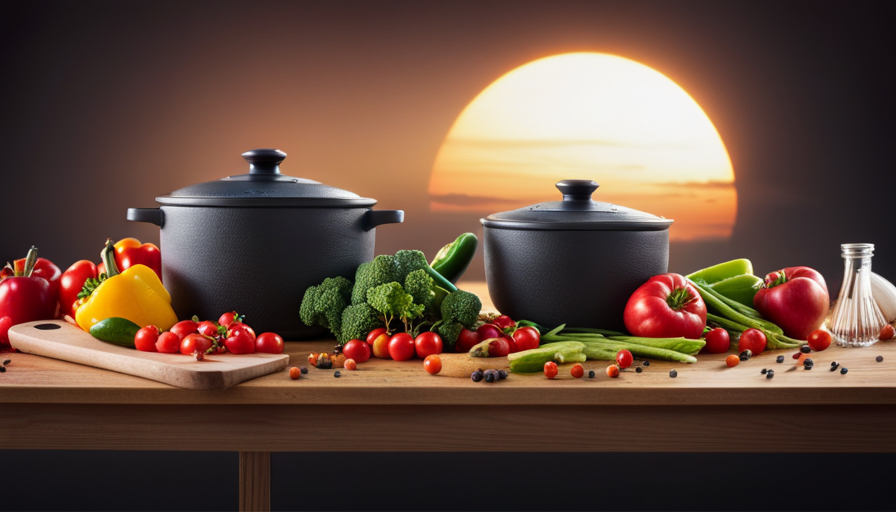
It’s quite a coincidence that you came across this piece just as you were searching for information on the best diet for dogs fighting cancer. You’ve found the right place! Nutrition plays a crucial role in helping our beloved furry friends battle cancer and can greatly affect their overall health and recovery.
But the question remains: is raw food, cooked food, or a combination of both better for canines battling cancer?
In this article, we will delve into the world of canine nutrition and explore the benefits of raw and cooked food for canines with cancer. We will also discuss the importance of evaluating the nutritional needs of canine cancer patients, considering digestive health and food safety, and assessing the impact of heat on nutrient loss.
So, grab a cup of tea, sit back, and let’s uncover the optimal diet to support our canine companions in their fight against cancer.
Key Takeaways
- Canine nutrition plays a crucial role in the well-being and recovery of dogs fighting cancer.
- The benefits and risks of raw food, cooked food, and a combination of both should be explored for canines with cancer.
- Canine gut health is important in fighting cancer and strengthening the immune system.
- Foods rich in antioxidants, such as blueberries, broccoli, and spinach, can support cancer treatment in dogs.
Understanding Canine Nutrition and Cancer
Are you curious about how your dog’s diet can affect their cancer treatment? Understanding canine nutrition and its correlation with cancer is crucial in ensuring the overall well-being of your furry companion.
When it comes to fighting cancer in canines, paying attention to their diet is of utmost importance. One key aspect to consider is canine gut health. The health of your dog’s gut plays a significant role in their overall health, including their ability to fight cancer. A diet that supports a healthy gut can help strengthen their immune system and improve their chances of combating cancer.
Additionally, incorporating foods rich in antioxidants can have a positive impact on your dog’s cancer treatment. Antioxidants are compounds that help protect the body from harmful free radicals, which can contribute to the development and progression of cancer. By including foods such as blueberries, broccoli, and spinach in your dog’s diet, you’re providing them with a good source of antioxidants. These antioxidants can help reduce inflammation, support the immune system, and potentially slow down the growth of cancer cells.
When it comes to fighting cancer in canines, paying attention to their diet is essential. Focus on maintaining a healthy gut and incorporating foods rich in antioxidants. By doing so, you can provide your dog with the best chance at fighting cancer and improving their overall well-being.
The Benefits of Raw Food for Canines with Cancer
Indulging in a succulent feast of nature’s bounty, your furry companion’s health blossoms like a vibrant garden in the springtime. When it comes to canines fighting cancer, raw food diets offer a myriad of benefits.
Research suggests that raw food diets can provide essential nutrients that support the immune system and promote overall well-being in dogs with cancer.
However, it’s important to be aware of the potential risks associated with raw food diets for canines with cancer. Raw food may contain harmful bacteria such as Salmonella or E. coli, which can pose a threat to the weakened immune system of a dog battling cancer. To mitigate these risks, it’s crucial to handle and prepare raw food with utmost care, ensuring proper hygiene and maintaining a clean feeding area.
Incorporating supplements into raw food diets is another strategy to enhance the nutritional support for canines with cancer. Supplements like omega-3 fatty acids, antioxidants, and probiotics can play a vital role in boosting the immune system and reducing inflammation. Consulting with a veterinary oncologist or a veterinary nutritionist can help determine the appropriate supplements and their dosages for your canine companion.
A raw food diet can be beneficial for canines with cancer, but it’s essential to be aware of the potential risks and take necessary precautions. With proper handling and the inclusion of supplements, raw food can provide the necessary nutrients to support your furry friend’s fight against cancer.
The Benefits of Cooked Food for Canines with Cancer
When prepared properly, cooked meals can provide a nourishing alternative for dogs battling cancer, offering a variety of health benefits. Cooking methods for canine cancer diets play a crucial role in maximizing nutrition and minimizing potential risks.
One of the main advantages of cooked food is that it can be easier for dogs with cancer to digest, especially if they have compromised immune systems or gastrointestinal issues. Cooking can break down the food, making it more accessible for absorption and reducing the risk of bacterial contamination.
Home cooked meals for dogs with cancer also allow for customization based on their specific dietary needs. You have the ability to carefully select ingredients that are rich in antioxidants, vitamins, and minerals, which can help support their immune system and overall health. Additionally, cooking can help improve the palatability of the food, making it more enticing for dogs who may have a decreased appetite due to cancer or its treatments.
It’s important to note that cooking methods should be gentle to preserve the nutritional value of the ingredients. Steaming, boiling, or lightly sautéing food can help retain important nutrients while ensuring the food is safe for consumption. Avoid overcooking or using high temperatures, as this can cause nutrient loss.
Overall, cooking can offer a nourishing and tailored approach to canine cancer diets. It allows you to provide a variety of nutrients while addressing specific dietary needs, giving your furry friend the best chance at fighting cancer.
Evaluating Nutritional Needs for Canine Cancer Patients
To ensure your furry friend has the best chance at fighting cancer, it’s crucial to evaluate their nutritional needs, just like a doctor would assess a patient’s diet.
When it comes to canine cancer patients, evaluating their dietary requirements becomes even more important. Cancer can take a toll on a dog’s body, weakening their immune system and causing weight loss. Therefore, providing them with the right nutrients is essential for their overall well-being and to support their fight against the disease.
One way to evaluate the nutritional needs of canine cancer patients is by considering dietary supplements. These supplements can help fill any nutritional gaps that may exist in their regular diet. They often contain essential vitamins, minerals, and antioxidants that can support the immune system and aid in the body’s natural defenses against cancer cells.
Speaking of antioxidants, they play a crucial role in cancer treatment. These powerful substances can help neutralize harmful free radicals in the body, which can cause damage to cells and contribute to the development and progression of cancer. Including foods rich in antioxidants, such as blueberries, spinach, and broccoli, can be beneficial for canine cancer patients.
Evaluating the nutritional needs of canine cancer patients is essential for their overall health and well-being. Incorporating dietary supplements and including antioxidant-rich foods can provide vital support in their fight against cancer. By taking these steps, you can help give your furry friend the best chance at a successful battle against this devastating disease.
Considering Digestive Health and Food Safety
Considering the importance of digestive health and ensuring food safety is crucial for supporting the overall well-being of canine cancer patients. When it comes to feeding dogs with cancer, it’s essential to pay close attention to their digestive health and take necessary precautions to prevent any potential risks.
Here are a few key points to explore regarding digestive health and food safety for canines fighting cancer:
-
Potential Risks:
- Raw Food: While some proponents argue that raw food diets are beneficial for dogs, there’s an increased risk of bacterial contamination such as Salmonella or E. coli. This can be especially dangerous for dogs with weakened immune systems due to cancer treatments.
- Cooked Food: Cooking food can eliminate potential pathogens, but it may also reduce the nutritional value of certain ingredients. It’s important to strike a balance between cooking and preserving nutrients.
-
Addressing Common Concerns:
- Consult with a Veterinary Nutritionist: They can provide tailored dietary recommendations that address the specific needs of your canine cancer patient.
- Choose High-Quality Ingredients: Opt for well-balanced, commercially prepared diets that meet the nutritional requirements of dogs with cancer.
- Practice Safe Food Handling: This includes washing hands thoroughly after handling food, cleaning food bowls regularly, and storing food properly to prevent contamination.
By considering the digestive health and food safety of canine cancer patients, you can help provide them with the best possible nutrition while minimizing potential risks. Always consult with a veterinarian to ensure you’re making informed decisions for your furry friend’s well-being.
Exploring the Role of Enzymes in Cancer Treatment
Enzymes play a crucial role in supporting the treatment of cancer in your furry friend, aiding in the breakdown and absorption of nutrients to support their overall well-being. Enzyme therapy has gained recognition as a complementary approach to cancer treatment in canines. These specialized proteins help in breaking down complex molecules into smaller, more easily absorbable forms, ensuring that your dog receives the necessary nutrients to fight the disease.
The role of enzymes in cancer treatment is not limited to aiding digestion. They can also help modulate the immune response, reduce inflammation, and support the body’s detoxification processes. By enhancing the body’s natural defense mechanisms, enzymes can potentially improve the efficacy of other cancer treatments, such as chemotherapy or radiation therapy.
To give you a clearer understanding of the importance of enzymes in cancer treatment, let’s take a look at this emotional evoking table:
| Enzyme Therapy Benefits | Emotional Impact |
|---|---|
| Improved nutrient absorption | Provides hope for better nourishment |
| Modulation of immune response | Offers a fighting chance |
| Reduction of inflammation | Eases discomfort and pain |
| Support for detoxification processes | Promotes overall well-being |
It is important to note that enzyme therapy should be used under the guidance of a veterinarian experienced in cancer treatment. They will be able to recommend the appropriate enzymes and dosage based on your dog’s specific condition. With the right approach, enzymes can be a valuable addition to the treatment plan for your beloved canine companion.
Assessing the Impact of Heat on Nutrient Loss
The scorching heat of the sun mercilessly robs essential nutrients from the nourishing sustenance. When it comes to fighting cancer in canines, nutrient preservation is vital. The impact of heat on nutrient loss is a crucial factor to consider when assessing the benefits of raw food versus cooked food.
Cooking methods play a significant role in determining the amount of nutrients retained in the food. The cooking process can cause chemical changes in food, leading to the degradation of vitamins, minerals, and enzymes. High temperatures can destroy heat-sensitive nutrients, such as vitamin C and B vitamins. However, cooking can also increase the bioavailability of certain nutrients, making them easier for the body to absorb.
Different cooking methods have varying effects on nutrient preservation. Boiling and steaming are known to cause the most significant nutrient loss, while methods like baking and roasting are more effective at retaining nutrients. It is important to note that overcooking can also lead to nutrient depletion.
To maximize nutrient preservation, it is recommended to use gentle cooking methods like lightly steaming or baking at lower temperatures. Additionally, incorporating a combination of raw and cooked foods in a canine’s diet can provide a balance of nutrients and enzymes. This approach ensures that the cancer-fighting properties of both raw and cooked foods are utilized effectively.
Balancing Protein, Fat, and Carbohydrates in Canine Cancer Diets
To achieve a well-balanced canine cancer diet, you should strive to maintain a proper ratio of protein, fat, and carbohydrates. Balancing macronutrients is crucial in supporting your dog’s overall health and fighting cancer.
Protein is especially important as it helps repair and build tissues, strengthens the immune system, and aids in the production of enzymes and hormones. Good sources of protein for canine cancer diets include lean meats, fish, eggs, and dairy products.
In addition to protein, the right amount and type of fats are essential for your dog’s well-being. Fats provide energy, help absorb certain vitamins, and support a healthy coat and skin. Opt for healthy fats like omega-3 fatty acids found in fish, flaxseed, and chia seeds.
Carbohydrates, on the other hand, should be chosen wisely. Stick to complex carbohydrates such as whole grains, fruits, and vegetables, which provide a steady source of energy and fiber.
When determining the optimal calorie intake for your dog, it’s important to consider factors such as their weight, size, activity level, and stage of cancer. Consult with a veterinarian or a veterinary nutritionist to calculate the appropriate calorie intake for your furry friend. They can also help you determine the ideal balance of macronutrients based on your dog’s specific needs.
Remember, a well-balanced canine cancer diet is a crucial part of supporting your dog’s overall health and well-being during their cancer fight. So, take the time to assess and adjust their food accordingly, ensuring they receive the necessary nutrients to aid in their battle against cancer.
Tailoring the Diet to Individual Canine Cancer Cases
When tailoring your dog’s diet to their individual cancer case, you can work with a veterinarian to determine the best balance of nutrients for their specific needs. This has been shown to significantly improve their overall well-being and treatment outcomes. Canine cancer nutrition is a crucial aspect of their care, as it plays a vital role in supporting their immune system and fighting against the disease.
By creating personalized dietary plans, you can ensure that your dog is receiving the right combination of nutrients to strengthen their body and enhance their response to treatment.
To evoke emotion in the audience, consider the following sub-lists:
-
Increased Energy: Providing your dog with a diet tailored to their cancer case can help boost their energy levels, allowing them to maintain their vitality and zest for life during treatment.
-
Enhanced Appetite: Cancer treatment can often lead to a decrease in appetite, but a personalized dietary plan can help stimulate their taste buds and encourage them to eat, ensuring they receive the necessary nutrition.
-
Improved Quality of Life: A well-balanced diet can enhance your dog’s overall well-being, helping them feel more comfortable during their treatment journey and improving their overall quality of life.
By focusing on personalized dietary plans, you can give your furry friend the best fighting chance against cancer while also improving their overall health and well-being. Remember to consult with a veterinarian to ensure you’re providing the right balance of nutrients for your dog’s specific needs.
Consulting with a Veterinarian for Nutritional Guidance
Consulting with a veterinarian is crucial for obtaining expert guidance on the appropriate nutritional plan for your dog’s individual cancer case. Veterinary expertise is essential in understanding the specific needs of your canine companion and tailoring their diet to optimize their health during cancer treatment.
A veterinarian can provide personalized recommendations based on factors such as the type and stage of cancer, the dog’s overall health, and any concurrent treatments. They can assess your dog’s nutritional status and advise on the best approach to meet their dietary requirements.
They can recommend specific foods or supplements that may help support the immune system, promote weight management, and reduce inflammation. Additionally, they can guide you on the appropriate balance between raw and cooked foods, considering your dog’s specific condition.
Furthermore, a veterinarian can monitor your dog’s response to the nutritional plan and make necessary adjustments as needed. They can provide ongoing support and guidance throughout the treatment process, ensuring that your dog receives the best possible care.
Remember, each canine cancer case is unique, and what works for one dog may not be suitable for another. Consulting with a veterinarian who specializes in oncology or nutrition will help ensure that your dog’s dietary needs are met with expert guidance and personalized recommendations.
Frequently Asked Questions
How does understanding canine nutrition help in fighting cancer in canines?
Understanding canine nutrition is crucial when it comes to fighting cancer in canines. By having a deep understanding of their nutritional needs, you can provide them with the right diet to support their immune system and overall health.
Proper nutrition can help combat the effects of cancer and improve their quality of life. By incorporating a balanced diet, you can ensure that your furry friend is getting the necessary nutrients to fight off cancer and stay strong.
Are there any benefits of feeding raw food to canines with cancer?
Feeding raw food to canines with cancer has some potential benefits, but it also comes with its share of pros and cons.
On the positive side, raw food diets typically contain high-quality ingredients that can support the immune system and overall health.
However, transitioning to a raw food diet may be challenging for some dogs, especially those with compromised digestive systems.
It’s important to consult with a veterinarian and consider all factors before making any dietary changes for a canine with cancer.
What are the benefits of feeding cooked food to canines with cancer?
Feeding cooked food to canines with cancer offers a range of nutritional benefits that can aid in their fight against the disease. Cooked food is easier to digest, ensuring that essential nutrients are readily absorbed by their bodies. This increased digestibility allows canines to maintain a healthy weight and support their immune system.
Additionally, cooked food can be customized to meet specific dietary requirements, providing canines with the necessary nutrients to combat cancer.
How do you evaluate the nutritional needs of canine cancer patients?
To evaluate the nutritional needs of canine cancer patients, you need to consider various factors. Start by assessing the dog’s overall health, stage of cancer, and any existing dietary restrictions.
Consult with a veterinarian or veterinary nutritionist to create a tailored diet plan. Focus on providing a balanced diet that includes high-quality proteins, healthy fats, and appropriate amounts of carbohydrates.
Consider dietary supplements and antioxidants to support the dog’s immune system. Keep in mind that individual dogs may have unique dietary considerations, so it’s crucial to monitor their response and adjust the diet accordingly.
Is digestive health and food safety important when considering a diet for canines with cancer?
When considering a diet for canines with cancer, digestive health and food safety are crucial factors to keep in mind.
Ensuring that your dog’s digestive system is functioning optimally is essential for their overall well-being. Additionally, prioritizing food safety will help reduce the risk of any potential complications or adverse reactions.
By focusing on these aspects, you can provide your furry friend with a diet that supports their health and aids in their fight against cancer.
Remember, as the saying goes, "You’re what you eat."
Does Switching to Raw Food Cause Lethargy in Canines Fighting Cancer?
Switching pets to a raw food transition during cancer treatment may cause lethargy initially. However, this adjustment period is normal as their bodies adapt to the new diet. Consult your vet for guidance on easing the transition to ensure your canine’s energy levels are supported during this critical time.
Conclusion
In conclusion, when it comes to fighting cancer in canines, there’s no one-size-fits-all answer. Both raw and cooked food can provide benefits for dogs with cancer, depending on their individual needs and preferences.
It’s crucial to evaluate nutritional needs, consider digestive health and food safety, and assess the impact of heat on nutrient loss. Interestingly, a study conducted by the Journal of Veterinary Internal Medicine found that a raw food diet can lead to a higher remission rate in dogs with lymphoma.
However, it’s essential to consult with a veterinarian for personalized nutritional guidance to ensure the best possible outcome for your furry friend.
Penelope, a talented writer for rachaelsrawfood.com, brings a unique perspective and a wealth of knowledge to the platform. With her exceptional writing skills and deep understanding of nutrition, she plays an integral role in conveying the benefits of raw food to a wide audience.
One of Penelope’s strengths lies in her ability to simplify complex concepts and make them accessible to a wide audience. She understands that not everyone has prior knowledge of raw food or nutrition, so she breaks down information in a way that is easy to understand without sacrificing accuracy. Her writing perfectly balances educational and engaging, allowing readers to grasp the concepts while enjoying the reading experience.
In addition to her writing contributions, Penelope actively collaborates with Rachael, the Editor in Chief, and the rest of the team at rachaelsrawfood.com. She participates in brainstorming sessions, offering creative ideas for new articles, recipes, and projects. Her passion for research ensures that the website’s content is current and evidence-based, providing readers with reliable information to support their raw food journey.
Benefits of Raw Food
I Ate Raw Food Few Times When I’m Pregnant
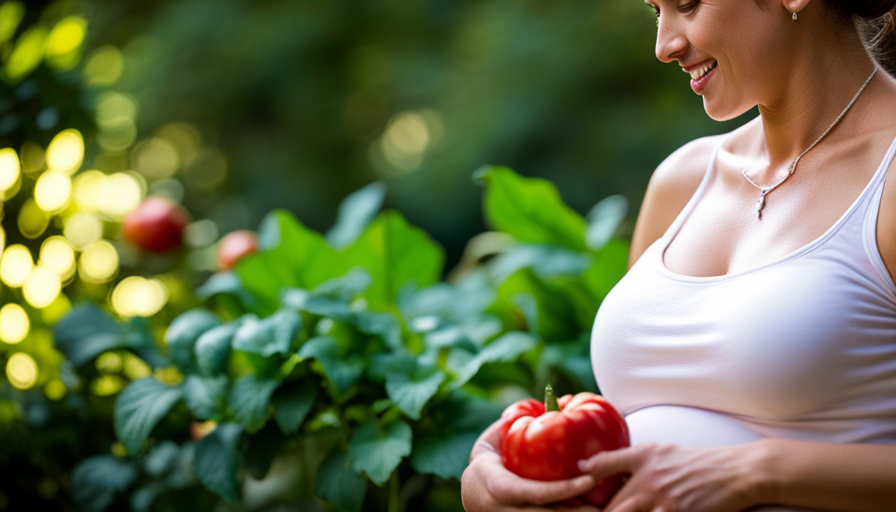
Did you know that some women choose to follow a raw food diet during pregnancy? It’s true! The Raw Food Movement has become increasingly popular recently, with more people embracing the idea of consuming foods in their raw, uncooked state for the health benefits they believe it provides.
But what about when you’re expecting a little one? Can you still enjoy the benefits of raw food while pregnant? In this article, we will explore the nutritional benefits of raw foods, as well as the potential risks involved in eating them during pregnancy. We will also discuss the importance of ensuring food safety and consulting with a healthcare professional.
So, if you’re curious about incorporating raw fruits and vegetables into your diet or are simply looking for some delicious raw food recipes for pregnant women, keep reading. We will help you make informed decisions for a healthy and satisfying pregnancy journey.
Key Takeaways
- Raw food can be incorporated into a pregnancy diet with caution.
- Precautions should be taken to minimize the risks of foodborne illnesses.
- Proper food safety practices are crucial during pregnancy.
- Consultation with a healthcare professional is important before making dietary changes.
Understanding the Raw Food Movement
You’ve probably heard about the Raw Food Movement, but have you ever truly understood the power of nourishing your body with unprocessed, living foods?
Raw food recipes have gained popularity in recent years, as more and more people are realizing the benefits of incorporating raw foods into their diets.
One of the main benefits of raw food is that it retains all of its natural enzymes and nutrients, which can be lost during the cooking process. Enzymes are essential for digestion and the absorption of nutrients, so by consuming raw foods, you can ensure that you’re getting the maximum nutritional value from your meals.
Additionally, cooking can sometimes destroy certain vitamins and minerals in food. For example, vitamin C is sensitive to heat and can be easily destroyed when cooked. By eating raw fruits and vegetables, you can ensure that you’re getting the full spectrum of vitamins and minerals that they contain.
However, it’s important to note that not all foods are safe to eat raw. Some foods, like meat and eggs, can contain harmful bacteria that can only be killed through cooking. It’s crucial to practice proper food safety when preparing and consuming raw foods, especially during pregnancy, to minimize the risk of foodborne illnesses.
The raw food movement offers a variety of benefits, including increased nutrient intake and preservation of vital enzymes and vitamins. However, it’s important to be mindful of food safety guidelines and choose raw foods wisely to ensure a healthy and balanced diet.
Nutritional Benefits of Raw Foods
Indulging in the natural goodness of uncooked ingredients during this special time can provide a wealth of nourishing benefits for both you and your little one. The raw food movement has gained popularity in recent years, and many pregnant women are considering incorporating raw foods into their pregnancy diet. But what exactly are the benefits of raw food in pregnancy?
Raw foods are rich in vitamins, minerals, and enzymes that can support your baby’s development and boost your own health. They are also packed with antioxidants, which help protect your body from oxidative stress and inflammation. By including raw fruits and vegetables in your diet, you can ensure a good intake of essential nutrients like vitamin C, folate, and potassium.
To give you a better idea of the nutritional benefits, take a look at the table below:
| Nutrient | Raw Fruits | Raw Vegetables |
|---|---|---|
| Vitamin C | High | High |
| Folate | Moderate | High |
| Potassium | Moderate | High |
| Antioxidants | High | High |
| Enzymes | High | Moderate |
Incorporating raw food into your pregnancy diet can be as simple as adding a fresh salad or a fruit smoothie to your daily meals. However, it’s important to note that not all raw foods are safe for consumption during pregnancy. Some raw foods, like unpasteurized dairy products and certain seafood, can pose a risk of foodborne illnesses. Therefore, it’s essential to consult with your healthcare provider before making any significant changes to your diet.
Incorporating raw foods into your pregnancy diet can provide a range of nutritional benefits for both you and your baby. However, it’s crucial to make informed choices and prioritize food safety to ensure a healthy and enjoyable pregnancy journey.
Potential Risks of Eating Raw Food during Pregnancy
Be cautious about the potential risks of consuming uncooked ingredients while expecting. Although raw foods can offer numerous nutritional benefits, it’s important to be aware of the potential dangers they may pose during pregnancy.
Raw foods, such as raw eggs, raw meat, and unpasteurized dairy products, can harbor harmful bacteria like Salmonella, E. coli, and Listeria, which can lead to serious infections and complications for both the mother and the baby.
To minimize these risks, it’s crucial to take certain precautions when it comes to consuming raw foods. Firstly, ensure that all raw meat, poultry, and seafood are cooked thoroughly to kill any potential pathogens. Avoid consuming raw or undercooked eggs and opt for pasteurized versions instead. Additionally, it’s recommended to avoid unpasteurized dairy products, including certain soft cheeses, as they can contain Listeria bacteria. Washing fruits and vegetables thoroughly before consumption is also important to remove any traces of bacteria or pesticides.
It’s wise to consult with a healthcare professional or a registered dietitian for guidance on a safe and balanced diet during pregnancy. They can provide personalized recommendations based on your specific needs and circumstances. By being cautious and taking these necessary precautions, you can ensure the safety of both you and your baby while still enjoying a varied and nutritious diet.
Ensuring Food Safety during Pregnancy
To ensure the safety of your meals during pregnancy, it’s important to follow proper food handling and storage practices. This includes refrigerating leftovers within two hours to prevent bacterial growth. Did you know that according to the Centers for Disease Control and Prevention, about 1 in 6 Americans get sick from foodborne illnesses each year?
To ensure proper food storage and avoid harmful bacteria, here are some important tips to keep in mind:
- Keep your refrigerator at or below 40°F (4°C) to slow down the growth of bacteria.
- Store raw meat, poultry, and seafood in separate containers or plastic bags to prevent cross-contamination.
- Wash your hands thoroughly with soap and water before and after handling food.
- Use separate cutting boards for raw meats and vegetables to prevent the spread of bacteria.
- Cook food thoroughly, especially meat, poultry, and eggs, to kill any harmful bacteria that may be present.
By following these guidelines, you can greatly reduce the risk of foodborne illnesses during pregnancy. It’s also important to be aware of the specific foods that are more prone to carrying harmful bacteria, such as unpasteurized dairy products, raw sprouts, and certain types of fish like shark, swordfish, and king mackerel.
Remember, ensuring proper food storage and avoiding harmful bacteria is crucial for the health and well-being of both you and your baby.
Consulting with a Healthcare Professional
When you consult with a healthcare professional, they can provide you with valuable guidance and support throughout your pregnancy journey. It is important to seek their advice when it comes to ensuring food safety and making dietary choices.
One aspect to consider is seeking second opinions. While your healthcare professional is knowledgeable and experienced, it can be beneficial to get a different perspective from another healthcare provider. They may offer alternative suggestions or confirm the recommendations given by your primary healthcare provider.
When it comes to considering alternative dietary options, your healthcare professional can help you make informed decisions. If you have concerns about eating raw food during pregnancy, they can provide you with evidence-based information on the potential risks and benefits. They can discuss the nutritional needs of both you and your baby and help you understand how to meet those needs while minimizing any potential risks.
Your healthcare professional can also guide you in finding alternative ways to enjoy the foods you love while ensuring safety. For example, if you enjoy sushi, they may suggest trying cooked sushi rolls or vegetarian options instead. They can provide you with a list of safe alternatives and help you create a balanced and nutritious meal plan.
Remember, consulting with a healthcare professional is essential during pregnancy. They can offer valuable advice, answer your questions, and provide the support you need to have a healthy and safe pregnancy.
Balancing Raw and Cooked Foods in Pregnancy
Finding a balance between raw and cooked foods is crucial during pregnancy, and research shows that incorporating a variety of cooked vegetables into your diet can provide essential nutrients for both you and your baby.
While it’s important to listen to your cravings and include raw foods in your diet, it’s equally important to be aware of certain misconceptions surrounding raw food consumption during pregnancy.
Cravings during pregnancy are common and can include a desire for raw foods. However, it’s important to be cautious when consuming raw foods, especially when it comes to certain types of produce. Raw vegetables can harbor harmful bacteria such as E. coli or Salmonella, which can pose a risk to both you and your baby.
Cooking vegetables can help eliminate these bacteria and make them safer to consume.
Another misconception surrounding raw food consumption during pregnancy is the belief that raw foods are always more nutritious. While raw fruits and vegetables do contain beneficial enzymes and nutrients, cooking certain vegetables can actually enhance their nutritional value. For example, cooking carrots can increase the availability of beta-carotene, which is important for your baby’s development.
Finding a balance between raw and cooked foods is essential during pregnancy. It’s important to listen to your cravings but also be aware of the potential risks associated with consuming raw foods.
Incorporating a variety of cooked vegetables into your diet can provide essential nutrients for both you and your baby. Remember to consult with your healthcare professional for personalized guidance on maintaining a healthy diet during pregnancy.
Listening to Your Body’s Needs
Pay attention to the signals your body is sending you during pregnancy, as it may be craving certain types of nourishing foods that can provide the essential nutrients you and your baby need.
Listening to your body’s needs is crucial during this time, as it can guide you towards making healthier choices. Pregnancy cravings are common and can range from specific food items to unusual combinations. While it’s important to indulge in your cravings occasionally, it’s equally important to maintain a balanced diet.
When you experience cravings, it’s essential to consider what your body might be lacking. For example, if you’re craving sweets, it could be a sign that your body needs more energy. Instead of reaching for processed sugary treats, opt for natural sources of sweetness like fruits.
Similarly, if you’re craving salty foods, it could mean your body needs more electrolytes. In this case, incorporate foods like nuts, seeds, and avocados into your diet.
Remember, cravings are not always a reliable indicator of what your body truly needs. It’s crucial to consult with your healthcare provider or a registered dietitian to ensure you’re meeting your nutritional requirements. They can provide guidance on maintaining a healthy balance between raw and cooked foods, while considering any specific dietary restrictions or concerns you may have during pregnancy.
By listening to your body’s needs and seeking professional advice, you can make informed choices to nourish yourself and your growing baby.
Incorporating Raw Fruits and Vegetables into Your Diet
Listening to your body’s needs is essential during pregnancy, and incorporating raw fruits and vegetables into your diet can provide numerous benefits. Raw food preparation techniques can help you maintain the nutrients and enzymes found in these foods, which can support your overall health and well-being.
-
Choose fresh, organic produce: Selecting high-quality fruits and vegetables ensures that you’re consuming the best nutrients for you and your baby.
-
Wash thoroughly: It’s important to wash your produce thoroughly to remove any potential contaminants or pesticides.
-
Use proper food storage: Storing your raw fruits and vegetables correctly can help maintain their freshness and prevent spoilage.
-
Gradually introduce raw foods: If you’re new to incorporating raw foods into your diet, start by adding small portions and gradually increase over time.
While a raw food diet during pregnancy may offer certain benefits, it’s crucial to consult with your healthcare provider before making any significant dietary changes. They can provide personalized guidance based on your specific needs and ensure that you’re meeting all your nutritional requirements. Remember, maintaining a balanced and varied diet is key to a healthy pregnancy.
Exploring Raw Food Recipes for Pregnant Women
Trying out new and delicious raw food recipes can be a fun and nutritious way for pregnant women to explore different flavors and textures during their journey to motherhood.
For example, Sarah, a soon-to-be mom, discovered a tasty kale and avocado salad recipe that provided her with a boost of energy and essential nutrients throughout her pregnancy. This salad was not only packed with vitamins and minerals, but it also had a refreshing taste that helped with her morning sickness.
In addition to salads, exploring juicing options can be a great way for pregnant women to incorporate raw fruits and vegetables into their diet. Sarah found that juicing allowed her to consume a wide variety of fruits and vegetables in one convenient drink. She loved experimenting with different combinations, like spinach and apple or carrot and ginger, to create delicious and nutrient-rich juices.
Incorporating raw nuts and seeds into meals and snacks is another way to add nutrition to a pregnant woman’s diet. Sarah enjoyed making homemade energy balls with raw almonds, dates, and chia seeds. These energy balls were not only a tasty and convenient snack, but they also provided her with a good source of protein, healthy fats, and essential minerals.
Overall, exploring raw food recipes can be an exciting and beneficial experience for pregnant women. It allows them to discover new flavors, textures, and nutritional benefits that can support their health and the growth of their baby.
Making Informed Decisions for a Healthy Pregnancy
If you’ve been exploring raw food recipes for pregnant women, it’s important to make informed decisions for a healthy pregnancy. The raw food movement has gained popularity in recent years, with many people opting for a diet that includes uncooked, unprocessed foods. However, when it comes to pregnancy, there are some important considerations to keep in mind.
Food safety during pregnancy is crucial, as certain foods can pose risks to both you and your baby. Raw foods, especially meats, seafood, and eggs, may contain harmful bacteria such as Salmonella or Listeria. These bacteria can lead to foodborne illnesses, which can have serious consequences for pregnant women and their unborn babies.
To ensure a healthy pregnancy, it’s essential to take precautions when it comes to raw foods. Here are three important factors to consider:
-
Proper food handling: Make sure to wash all fruits and vegetables thoroughly before consuming them. Avoid cross-contamination by keeping raw and cooked foods separate.
-
Safe food choices: Opt for cooked meats, seafood, and eggs instead of consuming them raw. This will help eliminate any potential risks associated with these foods.
-
Consult your healthcare provider: If you have any concerns or questions about incorporating raw foods into your pregnancy diet, it’s always best to consult with your healthcare provider. They can provide personalized advice based on your specific needs and circumstances.
By making informed decisions and following these guidelines, you can enjoy a healthy pregnancy while still exploring the raw food movement.
Frequently Asked Questions
Can I eat sushi during pregnancy?
Yes, you can eat sushi during pregnancy, but it’s recommended to choose cooked fish instead of raw. Incorporating cooked fish into your pregnancy diet offers numerous benefits. Cooked fish provides essential nutrients like omega-3 fatty acids, protein, and vitamins.
On the other hand, consuming raw fish during pregnancy poses risks of bacterial and parasitic infections, which can harm both you and your baby. It’s best to prioritize your health and opt for cooked fish options to ensure a safe and healthy pregnancy.
How can I ensure that the raw fruits and vegetables I consume are safe for me and my baby?
To ensure the safety of both you and your baby, it’s crucial to thoroughly wash raw fruits and vegetables during pregnancy. This simple step helps remove any potential contaminants that may be present on the surface.
Additionally, it’s important to avoid consuming unpasteurized juices and smoothies while pregnant. These products can pose a risk of bacterial contamination, which may lead to foodborne illnesses.
By taking these precautions, you can enjoy the health benefits of raw produce while minimizing any potential risks.
Are there any specific raw food recipes that are recommended for pregnant women?
To satisfy your raw food cravings during pregnancy, there are several safe and delicious options to explore. Raw salads with fresh vegetables and fruits can provide you with essential nutrients and fiber. Smoothies made with raw fruits, vegetables, and yogurt are also a great choice.
Raw snacks like carrot sticks, cucumber slices, and apple wedges can be enjoyed with a healthy dip. Remember, consuming raw food in moderation can have numerous benefits, including increased vitamin and enzyme intake. However, it’s important to consult with your healthcare provider for personalized advice.
Can I still consume cooked foods while incorporating raw foods into my diet during pregnancy?
Yes, you can still consume cooked foods while incorporating raw foods into your pregnancy diet. For example, many pregnant women choose to have a salad with raw vegetables as a side dish to their cooked meal.
Incorporating raw foods into your diet during pregnancy can provide numerous benefits such as increased intake of vitamins, minerals, and antioxidants. To safely incorporate raw foods, make sure to wash them thoroughly, choose organic options, and avoid high-risk foods like unpasteurized dairy and raw seafood.
What are some signs that my body may be craving raw foods during pregnancy?
During pregnancy, it’s important to listen to your body’s cravings. Craving raw foods could be a sign that your body needs the benefits they offer.
Incorporating raw foods into your pregnancy diet can provide essential nutrients like vitamins, minerals, and enzymes. They can also be a good source of hydration and fiber.
However, it’s crucial to remember that balance is key. Make sure to consult with your healthcare provider and practice proper food safety when consuming raw foods.
What Are the Risks of Eating Raw Food While Pregnant?
Pregnant women should be cautious with their observations with raw food. There is a risk of consuming harmful bacteria like salmonella and listeria, which can lead to serious complications for both the mother and the baby. It’s important to thoroughly cook all meat and eggs and avoid unpasteurized dairy products to minimize these risks.
Conclusion
Congratulations on completing the article! Now that you’ve learned about the raw food movement and the potential risks and benefits of eating raw food during pregnancy, it’s time to make informed decisions for a healthy pregnancy.
Remember, "You’re what you eat." So, listen to your body’s needs, ensure food safety, and consult with a healthcare professional.
Incorporate delicious raw fruits and vegetables into your diet and explore raw food recipes specifically designed for pregnant women.
With these tips, you can nourish yourself and your growing baby while enjoying the benefits of raw foods.
Penelope, a talented writer for rachaelsrawfood.com, brings a unique perspective and a wealth of knowledge to the platform. With her exceptional writing skills and deep understanding of nutrition, she plays an integral role in conveying the benefits of raw food to a wide audience.
One of Penelope’s strengths lies in her ability to simplify complex concepts and make them accessible to a wide audience. She understands that not everyone has prior knowledge of raw food or nutrition, so she breaks down information in a way that is easy to understand without sacrificing accuracy. Her writing perfectly balances educational and engaging, allowing readers to grasp the concepts while enjoying the reading experience.
In addition to her writing contributions, Penelope actively collaborates with Rachael, the Editor in Chief, and the rest of the team at rachaelsrawfood.com. She participates in brainstorming sessions, offering creative ideas for new articles, recipes, and projects. Her passion for research ensures that the website’s content is current and evidence-based, providing readers with reliable information to support their raw food journey.
-

 Raw Food Ingredients2 months ago
Raw Food Ingredients2 months agoHow To Make Hot Chocolate With Raw Cacao Powder
-

 Raw Food Ingredients2 months ago
Raw Food Ingredients2 months agoHow To Make Chocolate From Raw Cacao
-

 What is Raw Food?2 weeks ago
What is Raw Food?2 weeks agoHow To Remove Raw Mustard Oil Smell From Cooked Food
-

 Raw Food Ingredients4 weeks ago
Raw Food Ingredients4 weeks agoRaw Cacao Powder How Much For 8 Oz Hot Chocolate Recipe
-
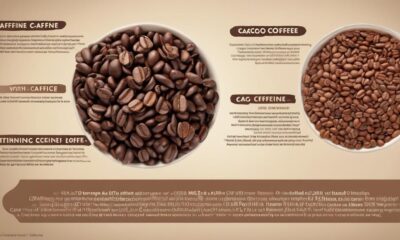
 Raw Food Ingredients4 weeks ago
Raw Food Ingredients4 weeks agoThe Truth Behind the Cacao Caffeine Myth
-

 Raw Food Ingredients2 months ago
Raw Food Ingredients2 months agoWhen Fasting Can I Drink Coffee With Raw Cacao Powder
-

 What is Raw Food?2 weeks ago
What is Raw Food?2 weeks agoHow To Store Raw And Cooked Food Separately
-

 Raw Food Ingredients2 months ago
Raw Food Ingredients2 months agoHow To Use Raw Cacao Beans





